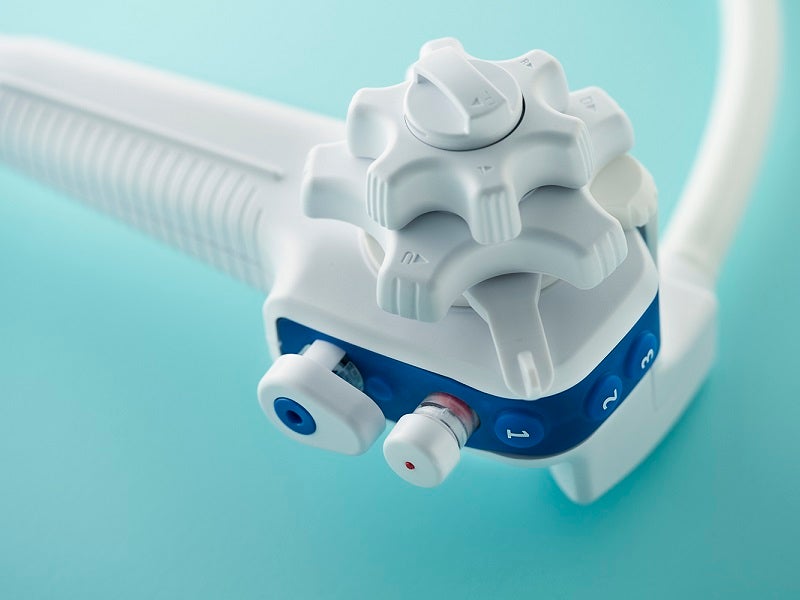
Duodenoscopes are used to diagnose and treat illnesses of the pancreas and bile ducts and are lowered into the upper part of the small intestine via the mouth in a procedure known as endoscopic retrograde cholangiopancreatography (ERCP). Steam heat sterilising can create cracks in the scopes where bacteria can settle, so after each procedure they need to be taken apart and manually hand-scrubbed before being run through liquid chemical disinfection or gas sterilisation.
Despite this, the many small moving parts can still harbour microscopic traces of bacteria and other pathogens even after thorough cleansing, which can be transferred between patients and cause serious illness. As a result, the US Food and Drug Administration (FDA) has been putting pressure on duodenoscope manufacturers to change their designs, and the US Centers for Medicare & Medicaid Services (CMS) has been working to speed up Medicare beneficiaries’ access to single-use devices.
Ambu’s aScope Duodeno, a sterile, single-use scope, has now received 501(k) clearance from the FDA. Having obtained the clearance, Ambu will be initiating a 500-patient post-market study at multiple centres in the US, which it plans to make public during the first quarter of 2021, when data from at least 60 procedures is available. Ambu has stated that its disposable duodenoscopes will sell at $1,400 – $1,600 per device.
Over the next three years, Ambu plans to introduce 15 new devices across all major areas of endoscopy. This includes three additional devices specifically for gastrointestinal specialists: a colonoscope, a gastroscope and a cholangioscope.
Ambu now faces stiff competition from other medical device companies such as Boston Scientific, Pentax and Olympus, which are also developing disposable or semi-disposable scopes.
Many disposable duodenoscopes are emerging onto the market
Medtech giant Boston Scientific received breakthrough device designation from the FDA for the world’s first single-use duodenoscope, the EXALT Model D, in December 2019.
How well do you really know your competitors?
Access the most comprehensive Company Profiles on the market, powered by GlobalData. Save hours of research. Gain competitive edge.

Thank you!
Your download email will arrive shortly
Not ready to buy yet? Download a free sample
We are confident about the unique quality of our Company Profiles. However, we want you to make the most beneficial decision for your business, so we offer a free sample that you can download by submitting the below form
By GlobalDataThe company had planned a limited Q1 rollout, with a gradual scale-up in the second quarter and second half of the year, however its sales push was knocked by the onset of the Covid-19 pandemic, which left company reps unable to visit hospitals.
That said, the EXALT device has now been approved by CMS for transitional pass-through payment status, a ruling which extends to all single-use duodenoscopes. This means it is eligible for reimbursement for Medicare beneficiaries despite the fact cost data is still being collected by the agency, significantly expanding access to the device.
Pentax and Olympus have also been working on new duodenoscope designs, although theirs are not fully disposable. Instead, they come with certain disposable components to reduce the chance of contamination between uses without having to throw away the entire product.
Specifically, Pentax’s DEC HD duodenoscope features a disposable cap and elevator, while Olympus’ TJF-Q190V model features a single-use endcap and a novel flushing adapter that should give a better clean for its elevator mechanism. The DEC HD launched in the US in November last year, while Olympus’ model hit the market in February.
Semi-disposable scopes could be the way forward
An analysis published last year in the BMJ estimated that, on average, the per-procedure cost for ERCP performed with a disposable duodenoscope would range between $797 and $1547 in a US hospital, while ERCP performed with a reusable device would cost between $612 to $1362. A standard reusable duodenoscope lasts about three years and can cost around £35,000, with annual maintenance coming in at $1,451 per scope, but would still ultimately be cheaper for hospitals to source than multiple reusable devices. Around $185 extra per procedure doesn’t sound like a whole lot, until you consider the fact that 500,000 ERCPs are performed in US hospitals every year – should all those procedures transition to disposable devices, that’s roughly $92.5m in extra yearly costs for the US healthcare system.
There’s a case to be made that a duodenoscope with a disposable endcap may therefore be the most cost-effective option, as indicated by a modelling study presented at the Digestive Disease Week 2020 online meeting in May 2020. While the researchers acknowledged several limitations in their model, they estimated the per-use cost of a semi-disposable device to be $654.
Theoretically, this data could mean that devices like the DEC HD and TJF-Q190V may be a better option than the aScope or EXALT for hospitals that want to move away from reusable duodenoscopes, as they should be more cost-effective in the long run than fully disposable devices. That’s to say nothing of the eco-friendly credentials associated with having reusable elements at a time when humanity is facing a serious medical waste problem, which could be exacerbated by fully-disposable devices.
Interestingly, the Digestive Disease Week study also estimated disposable scopes would cost far more than the BMJ did, at $2,903 per use. The infection transmission rates associated with various reusable duodenoscope-cleaning procedures all sat somewhere between 0.1% and 0.5% in the study, while the infection rate associated with a disposable endcap scope sat at a solid 0.1%.







